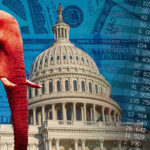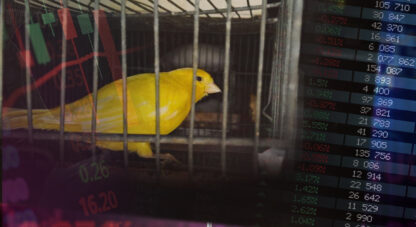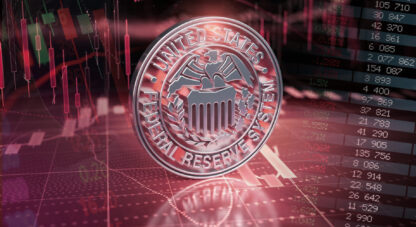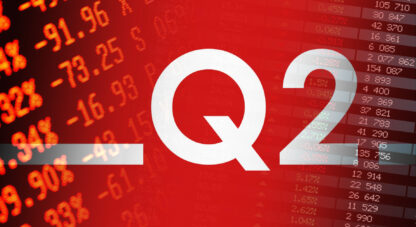June 21 – Neel Kashkari, Minneapolis Fed president: “In the Federal Open Market Committee meeting that concluded on Wednesday of this week, I advocated for a 50-basis-point rate cut to 1.75% to 2.00% and a commitment not to raise rates again until core inflation reaches our 2% target on a sustained basis. I believe an aggressive policy action such as this is required to re-anchor inflation expectations at our target.”
May 31 – Bloomberg (Matthew Boesler): “It’s too early for the Federal Reserve to begin cutting interest rates despite increasing concerns about low inflation and an escalating trade war, said Minneapolis Fed President Neel Kashkari. ‘Either of those could be cause for changing the path of monetary policy, Kashkari told Bloomberg… ‘I’m not quite there yet. I take a lot of comfort from the fact that the job market continues to be strong.’”
In three short weeks, Kashkari’s view evolved from “It’s too early” to begin cutting rates to advocating a dramatic 50 bps cut that in the past would have been in response to a market or economic shock. Yet nothing that extraordinary has occurred over recent weeks, outside of a major bond market rally that has the amount of global debt trading at negative yields jumping $2 TN to a record $13 TN (from Bloomberg). Unprecedented as well, talk is heating up for a 50 bps cut with the S&P500 at all-time highs (and corporate Credit spreads narrowing sharply and overall financial conditions loosening notably).
Markets, Rejoicing Central Banker Capitulation, have no intention of letting off the pressure. There will be unrelenting pressure as well on Chairman Powell to fall in line – or face demotion. Crazy.
Question from Bloomberg’s Chris Condon at Chairman Powell’s Wednesday post-meeting press conference: “Mr. Chairman, if and when the committee decides to cut rates, I suspect there will be a debate over whether to move by 25 or 50 bps. Indeed, there is a pretty substantial body of academic literature arguing that a central bank close to the zero lower bound ought to act sooner and more aggressively than it otherwise would. I’m wondering what you think of that prescription, and if you could spend a couple of minutes discussing the pros and cons of a 50 bps cut and how you approach that question.”
Powell: “On the specific question of that – that’s just something we haven’t really engaged with yet. And it will depend very heavily on incoming data and the evolving risk picture as we move forward. So, nothing I can say about that is specific to the near-term question that we face. More generally, though, the research you refer to essentially notes that in a world where you are closer to the effective lower bound – it’s why research kind of shows this – it’s wise to react, for example, to prevent a weakening from turning into a prolonged weakening. In other words, sort of an ounce of prevention is worth a pound of cure. So, I think that is a valid way to think about policy in this era. I don’t know – and it’s always in the minds of policymakers during this era – because it’s well-understood to be correct. Again, I don’t know what that means in terms of the size of a particular rate cut going forward. That’s going to depend heavily upon the actual data and the evolving risk picture.”
There’s a theory that, with interest rates not much above zero (“effective lower bound”), central banks must be ready to cut aggressively – employing their limited firepower early and forcefully – to “prevent a weakening from turning into a prolonged weakening.” I say theory – as opposed to “research” – because the experimental nature of the current monetary policy framework ensures minimal empirical data to analyze and draw conclusions.
In my view, this “act sooner and more aggressively” is the latest iteration of policy activism that further distances the Fed from its primary mandate of safeguarding system stability. December’s rapid emergence of systemic fragility (i.e. faltering Bubbles) emboldened the view that central banks must provide assurances they are prepared to quickly adopt “whatever it takes” measures to bolster the markets. From the perspective of highly speculative markets, the January “U-turn” unleashed a speculative fire and this month’s rush to dovishness (Fed, Draghi, PBOC, BOE, BOJ, etc.) pours gas on a flame. Countering Powell’s “an ounce of prevention is worth a pound of cure,” I would warn of the enormous cost of stoking blow-off “Terminal Phase Excess.” An ounce of late-cycle stimulus creates a pound of destabilizing excess.
Two long-held CBB themes should especially resonate these days. First, the fundamental problem with discretionary central banking (versus rules-based) is the propensity for a policy mistake to lead to a series of ever bigger blunders. Second, aggressive expansion of central bank Credit/balance sheets (aka “QE”/“money printing”) is a slippery slope eventually leading to a multitude of unintended consequences (including speculative market Bubbles, maladjusted economic structure, and trapped central bankers). Who back in 2008 anticipated the prospect of ongoing central bank purchases would be deeply embedded into global bond and securities prices – and market expectations more generally – a full decade later?
The QE naysayers at that time focused on the risk of inflation – and even hyperinflation – in consumer prices. However, the paramount issue was instead market distortions and hyperinflation in securities (and asset) prices, where perpetual QE essentially removes any ceiling on sovereign debt prices (floor on yields). Why shouldn’t exuberant traders imagine Treasury yields at some point trading at the current Swiss bond yield of negative 52 bps?
Why not leverage Treasuries (i.e. 10-yr at 2.06%) if the Fed will eventually become a price insensitive buyer of Trillions of these securities? Why not take levered positions in German bunds at negative 29 bps – better yet, Italian and Greek debt at 2.15% and 2.52% – appreciating it’s only a matter of (probably not much) time before the ECB fires back up the “electronic printing press.” Perhaps most consequential of all, why wouldn’t everyone speculating globally in the risk markets simultaneously leverage in sovereign debt, confident that aggressive global QE deployment devises the perfect market hedge? Why not hedge market risk with sovereign debt-related derivatives? In total, we have unearthed a recipe for history’s greatest episode of speculative leveraging (mortgage finance Bubble excess measly in comparison).
A crisis-period experiment in QE came with profound repercussions. The Fed’s 2011 “exit strategy” was supplanted the following year by Draghi’s “whatever it takes” – and there’s been no turning back. The prospect of Whatever and Whenever It Takes QE as essential to the global central banker toolkit has Changed Everything.
June 18 – Financial Times (Scott Mather): “Central banks around the world are pivoting toward easier monetary policy. In pursuit of a 2% target for inflation, major central banks seem willing to exhaust their monetary policy ammunition at a time when economic output is at — or above — potential. Unfortunately, there is little evidence to suggest that lower policy rates are successfully generating either better real growth outcomes or higher inflation. In some countries, this policy stance has the potential to reduce monetary policy effectiveness, create imbalances that may sow the seeds for the next crisis, and leave central banks powerless to respond to that crisis. It is time to ask whether the 2% inflation target has outlived its usefulness. Despite largely maintaining policy rates below their own estimated ‘neutral’ levels for more than a decade, the central banks of the US, euro zone and Australia, among others, have been guiding markets to expect lower rates for longer. This is happening even as employment rates are already above estimates of full capacity, and economic growth rates have been higher than what is deemed to be achievable in the ‘steady state’.”
There is indeed “little evidence to suggest that lower policy rates are successfully generating either better real growth outcomes or higher inflation.” Instead, there’s a strong case for the opposite: a decade of ultra-loose monetary policy has contributed to downward pressure on many consumer prices (along with deep economic maladjustment). China, India, greater Asia and the emerging economies in general have enjoyed an unprecedented period of protracted loose financial conditions, associated investment booms, and resulting overcapacity across industries.
No sector has benefited from loose global finance as much as technology. How can the global proliferation of myriad high-tech products and services not enter into today’s inflation discussion? There is today essentially unlimited supply of technology devices and services capable of absorbing much of whatever purchasing power can be thrown into economic systems. How great is the global capacity to manufacture smart phones, computers and servers, telecommunications equipment, and the “Internet of things” – not to mention a veritable deluge of technology-related services and downloadable content? What is the capacity for global online media to absorb swelling corporate marketing budgets?
The nature of output and overall economic structure has changed profoundly over the past 25 years. Historians and analysts will look back at this period and struggle to comprehend the blind focus on an arbitrary target for aggregate consumer price inflation, when securities markets and asset prices were going completely haywire.
“Globalization” remains complex subject matter. To simplify, highly integrated global finance has fundamentally loosened financial conditions for much (if not all) of the world. China, in particular, has “enjoyed” unlimited capacity to expand cheap Credit on a protracted basis to an extent never before possible. If not for global post-crisis zero rates and QE, China’s international reserve holdings would never have inflated from about $1.5 TN (end of ’07) to 2014’s high of $4.0 TN ($3.1 TN today). And without this massive reserve horde, renminbi stability would not have survived history’s greatest Credit inflation (i.e. total bank assets $7.2 TN to $41 TN since the end of ’07).
Globalization is tightly intertwined with experimental monetary policy. The world followed the U.S.’s lead in “activist” policy intervention, along with a related move to securitizations and market-based finance. Resulting market booms fundamentally loosened finance, stimulated investment and propelled economic growth. It also worked to exacerbate wealth disparities, within and between nations. Booms and Bubbles also ensured U.S.-style policy activism enveloped the world, with each new round of instability and attendant monetary stimulus further undermining the stability of markets, finance, economies, societies and geopolitics.
Today’s prescription for unstable markets and finance: more monetary stimulus. For unstable economies: more monetary stimulus. For inequality, trade wars and geopolitical uncertainties: much more monetary stimulus.
Couple momentous advancement in various technologies with globalized finance and policy activism and one has a remarkable backdrop with momentous ramifications for global price dynamics. I would argue strongly against conventional wisdom that holds the so-called “technology revolution” (with associated productivity gains and disinflationary pressures) granted central bankers greater latitude to boost growth through accommodative monetary policies. The primary focus, instead, should have been the powerful inflationary dynamics fueling asset prices and dangerous Bubbles. If there was an overarching lesson to be learned from the 2008 fiasco, it was that distorted financial markets and resulting Bubbles pose systemic risks that completely overshadow those that might emanate from rising consumer prices.
I am not against market-based finance per-se, although market-based Credit is notable for being inherently self-reinforcing on both the upside and downside. The problem arises when “activist” policymaking incentivizes the upside – fostering Bubbles. On the downside, faltering policy-induced Bubbles then ensure even more destabilizing policy activism. And in this Age of Market-Based Finance, the longer the recurring cycle of activism incentivizing excess and greater Bubbles the greater the risk of a crisis of confidence in policymaking and financial assets more generally. This miraculous game of massive issuance of new financial claims at increasing prices is unsustainable.
We’ve reached the point in this most extraordinary cycle where it’s become pretty clear that loose monetary policies have minimal impact on aggregate consumer prices and maximum influence on highly speculative securities and derivatives markets. The Fed is poised to cut rates – perhaps even 50 bps – essentially to sustain market Bubbles. With 10-year Treasury yields nearing 2% – and in excess of $13 TN of bonds trading globally with negative yields – sovereign bond markets have become completely divorced from traditional fundamentals. This equates to governments from Rome to Washington essentially being handed blank checkbooks. And with the (“risk free” sovereign debt) foundation of global finance in market dislocation, how sound are markets for equities and corporate Credit?
Capitalism is in clear and present danger. This sounds extreme – unless you’ve followed the trajectory of developments over the years. How are capitalistic systems to operate with central banks abrogating adjustments and corrections both for market and economic systems? It takes a tremendous amount of wishful thinking to believe that today’s markets will effectively allocate real and financial resources. Sound analysis also points to only more precarious imbalances and maladjustment on a global basis. And with global fragilities increasingly conspicuous, it’s reached the perilous point where markets believe central banks will preemptively flood the global system with liquidity to forestall “risk off” in the markets and recession globally.
June 20 – Financial Times (Don Weinland): “Banks in China are facing a pinch on liquidity following the government takeover of a commercial bank that is resetting the rules for trading in the country’s interbank market. Many of China’s more than 4,000 banks face difficulty raising deposits in smaller cities and rural areas, making them more reliant on wholesale borrowing from the interbank market, where banks lend to one another. But the government takeover of Baoshang Bank in May has disrupted the willingness of larger banks to lend to smaller ones, leaving some strained for liquidity… For interbank lenders, including some of China’s largest financial institutions, the treatment of Baoshang represents a sharp shift in the rules of the market. ‘It’s not just concern on credit risk, it’s also about the resolution mechanism [for defaults on interbank borrowings],’ said Katherine Lei, co-head of Asia ex-Japan banks research at JPMorgan. ‘What is the mechanism and how long does it take?’”
June 17 – Wall Street Journal (Stella Yifan Xie and Zhou Wei): “Chinese regulators made fresh attempts to calm frayed nerves in the country’s financial sector, as bank liquidity remained tight by some measures three weeks after authorities took over a struggling city lender. On Sunday, securities regulators summoned a group of large Chinese brokerages and asset-management firms to a closed-door meeting in Beijing and asked them not to cut off trading and other dealings with smaller banks and financial institutions, according to a meeting summary… The memo said there had been some defaults in the repo—or repurchase agreement—market, where banks, brokers and other financial firms borrow cash for short periods by pledging securities against short-term loans. It said some institutions in the debt markets had placed certain trading counterparties on a ‘blacklist’ and demanded they post higher-quality collateral against their borrowings. In other instances, some firms were cut off from trading because of worries that they would not repay their obligations, it said. ‘If such mistrust is allowed to continue to spread, it will eventually become systemic financial risk,’ the memo said, adding that mutual funds and brokers need to provide liquidity support to each other.”
June 18 – Wall Street Journal (Nathaniel Taplin): “While the world has been focused on the U.S.-China trade conflict, another threat—potentially just as large—has been brewing beneath the surface of China’s financial system. On Sunday, the country’s securities regulator convened a meeting asking big brokerages and funds to support their smaller peers… The briefing cited rising risk aversion in money markets after defaults in the bond repurchase market. Some interbank lending rates have moved sharply higher in recent weeks… Nonbank borrowing through bond repos and interbank loans has skyrocketed since China’s central bank began easing monetary policy in early 2018. It hit a net 74 trillion yuan ($10.7 trillion) in the first quarter of 2019, according to Enodo Economics, up nearly 50% from a year earlier… Worryingly, problems appear to be migrating from the relatively small market for negotiable certificates of deposit (NCDs)—used primarily by small banks—into the much larger bond repo market.”
With a flock of dovish central banks, collapsing yields and record stock prices, it’s easy to disregard China. Haven’t they, after all, repeatedly overcome bouts of heightened systemic stress. Beijing always gets things under control. The PBOC can effortlessly print “money” and bail out its troubled banking system. Not so fast… “Bond repos and interbank loans” up nearly 50% over the past year to $10.7 TN. Those are two data points that should alarm the world – and surely help explain panic buying of Trillions of negative-yielding global bonds.
President Trump has officially commenced his reelection campaign. He has ample incentive to avert a trade war showdown with China. Chinese finance is nearing the precipice. President Xi has ample incentive to avert a showdown. Yet if these two historic strongmen leaders have irreconcilable differences they have irreconcilable differences. Neither can tolerate any display of weakness or lack of resolve.
If Trump and Xi don’t get negotiations back on track at next week’s G20, there’s a scenario where things could turn sour rather quickly. An unfolding crisis of confidence in China’s money market portends serious trouble ahead for China’s financial and economic Bubbles. The PBOC has been injecting enormous quantities of liquidity into China’s financial system. Much, much more will be required. If there is as much leverage in that system as I suspect, Beijing will be on the hook for Trillions of liquidity injections, bank bailouts/recapitalizations and debt monetization.
It all implies currency vulnerability. The good news for China is that currency values are relative – and the renminbi competes against a throng of structurally weak currencies. Little wonder gold has caught such a nice bid. Quite an equities run into “quadruple witch” option expiration. A decent short squeeze in EM securities markets and currencies. And wild volatility in crude and energy prices. Central Bank Capitulation seems to have unleashed wild price instability throughout global markets. Things do get crazy during the late phase of Bubbles. We’re witnessing Bubbles and Craziness in historic proportions.
For the Week:
The S&P500 rose 2.2% (up 17.7% y-t-d), and the Dow gained 2.4% (up 14.5%). The Utilities added 1.1% (up 16.0%). The Banks slipped 0.3% (up 11.9%), while the Broker/Dealers increased 0.5% (up 11.1%). The Transports added 0.5% (up 12.9%). The S&P 400 Midcaps rose 1.5% (up 15.9%), and the small cap Russell 2000 jumped 1.8% (up 14.9%). The Nasdaq100 advanced 3.3% (up 22.1%). The Semiconductors jumped 4.0% (up 22.1%). The Biotechs surged 5.9% (up 12.9%). With bullion surging $58, the HUI gold index jumped 9.4% (up 12.9%).
Three-month Treasury bill rates ended the week at 2.055%. Two-year government yields fell seven bps to 1.77% (down 72bps y-t-d). Five-year T-note yields declined four bps to 1.79% (down 72bps). Ten-year Treasury yields slipped two bps to 2.06% (down 63bps). Long bond yields were unchanged at 2.58% (down 43bps). Benchmark Fannie Mae MBS yields dropped 14 bps to 2.73% (down 76bps).
Greek 10-year yields sank 18 bps to 2.52% (down 188bps y-t-d). Ten-year Portuguese yields declined three bps to 0.58% (down 114bps). Italian 10-year yields sank 20 bps to 2.15% (down 59bps). Spain’s 10-year yields fell six bps to 0.44% (down 98bps). German bund yields declined three bps to negative 0.29% (down 53bps). French yields dropped five bps to 0.05% (down 66bps). The French to German 10-year bond spread narrowed two to 34 bps. U.K. 10-year gilt yields were little changed at 0.85% (down 43bps). U.K.’s FTSE equities index increased 0.8% (up 10.1% y-t-d).
Japan’s Nikkei Equities Index added 0.7% (up 6.2% y-t-d). Japanese 10-year “JGB” yields declined three bps to negative 0.16% (down 16bps y-t-d). France’s CAC40 surged 3.0% (up 16.9%). The German DAX equities index rose 2.0% (up 16.9%). Spain’s IBEX 35 equities index increased 0.4% (up 8.0%). Italy’s FTSE MIB index jumped 3.8% (up 16.7%). EM equities were mostly higher. Brazil’s Bovespa index surged 4.1% (up 12.1%), while Mexico’s Bolsa gained 0.9% (up 4.5%). South Korea’s Kospi index increased 1.4% (up 4.1%). India’s Sensex equities index declined 0.7% (up 8.7%). China’s Shanghai Exchange jumped 4.2% (up 20.4%). Turkey’s Borsa Istanbul National 100 index rallied 3.6% (up 3.0%). Russia’s MICEX equities index increased 0.8% (up 16.5%).
Investment-grade bond funds saw inflows of $3.651 billion, and junk bond funds posted inflows of $602 million (from Lipper).
Freddie Mac 30-year fixed mortgage rates increased two bps to 3.84% (down 73bps y-o-y). Fifteen-year rates slipped a basis point to 3.25% (down 79bps). Five-year hybrid ARM rates declined three bps to 3.48% (down 35bps). Bankrate’s survey of jumbo mortgage borrowing costs had 30-yr fixed rates down five bps to 4.12% (down 49bps).
Federal Reserve Credit last week declined $1.1bn to $3.809 TN. Over the past year, Fed Credit contracted $471bn, or 11.0%. Fed Credit inflated $998 billion, or 36%, over the past 346 weeks. Elsewhere, Fed holdings for foreign owners of Treasury, Agency Debt jumped $16.3bn last week to $3.477 TN. “Custody holdings” rose $73.7bn y-o-y, or 2.2%.
M2 (narrow) “money” supply surged $40.9bn last week to a record $14.729 TN. “Narrow money” rose $628bn, or 4.5%, over the past year. For the week, Currency increased $0.9bn. Total Checkable Deposits dropped $62.8bn, while Savings Deposits surged $94.5bn. Small Time Deposits gained $5.5bn. Retail Money Funds added $3.0bn.
Total money market fund assets rose $12.6bn to $3.184 TN. Money Funds gained $344bn y-o-y, or 12.1%.
Total Commercial Paper rose $13.8bn to $1.113 TN. CP was up $10.1bn y-o-y, or 0.9%.
Currency Watch:
June 17 – Reuters (Gertrude Chavez-Dreyfuss): “China’s holdings of U.S. Treasuries for the month of April fell to the lowest level since May 2017…, highlighting an uncertain outlook on a trade deal between Beijing and Washington. Chinese holdings of U.S. government debt, which declined for a second straight month, slid to $1.113 trillion in April, from $1.120 trillion the previous month.”
The U.S. dollar index declined 1.4% to 96.22 (unchanged y-t-d). For the week on the upside, the South African rand increased 3.4%, the Norwegian krone 2.5%, the Swiss franc 2.3%, the Brazilian real 2.0%, the South Korean won 1.8%, the New Zealand dollar 1.5%, the Swedish krona 1.5%, the Canadian dollar 1.5%, the euro 1.4%, the Singapore dollar 1.2%, the British pound 1.2%, the Japanese yen 1.2%, the Australian dollar 0.8% and the Mexican peso 0.2%. The Chinese renminbi gained 0.83% versus the dollar this week (up 0.15% y-t-d).
Commodities Watch:
The Bloomberg Commodities Index gained 1.3% this week (up 2.4% y-t-d). Spot Gold surged 4.3% to $1,400 (up 9.1%). Silver recovered 3.8% to $15.37 (down 1.1%). WTI crude rallied $4.92 to $57.43 (up 27%). Gasoline surged 7.2% (up 40%), while Natural Gas sank 8.4% (down 26%). Copper rallied 2.8% (up 3%). Wheat declined 1.4% (up 6%). Corn was little changed (up 21%).
Market Instability Watch:
June 18 – Bloomberg (Shawn Donnan, Rich Miller, and Katherine Greifeld): “President Donald Trump has already given the global economy trade wars. Now there are signs he may be gearing up for a currency war, too. With a series of tweets… aimed at the European Central Bank and an announcement by Mario Draghi, its president, that he was prepared to cut interest rates further below zero in response to Europe’s slowing growth, Trump made a rare American presidential intervention into another economy’s monetary policy. ‘Mario Draghi just announced more stimulus could come, which immediately dropped the Euro against the Dollar, making it unfairly easier for them to compete against the USA. They have been getting away with this for years, along with China and others,’ he tweeted. Later, he added: ‘German DAX way up due to stimulus remarks from Mario Draghi. Very unfair to the United States!’”
Trump Administration Watch:
June 18 – Reuters (Jeff Mason): “China and the United States are rekindling trade talks ahead of a meeting next week between Presidents Donald Trump and Xi Jinping, cheering financial markets on hopes that an escalating trade war between the two countries would abate. Trump said on Tuesday that teams from the two sides would begin preparations for the leaders to sit down at the G20 summit in Osaka. China, which previously declined to say whether the two leaders would meet, confirmed the get-together. ‘Had a very good telephone conversation with President Xi of China. We will be having an extended meeting next week at the G-20 in Japan. Our respective teams will begin talks prior to our meeting,’ Trump said… on Twitter.”
June 17 – CNBC (Elliot Smith): “President Donald Trump is ready to proceed with tariffs on the remaining $300 billion in Chinese goods in the absence of a trade deal, according to U.S. Commerce Secretary Wilbur Ross. …Ross said enforcement would be the most important element of any potential deal between the world’s two largest economies. ‘We will eventually make a deal, but if we don’t, the president is perfectly happy with continuing the tariff movements that we’ve already announced, as well as imposing the new ones that he has temporarily suspended,’ Ross said.”
June 19 – Bloomberg (Jennifer Jacobs and Saleha Mohsin): “President Donald Trump has told confidants as recently as Wednesday that he believes he has the authority to replace Jerome Powell as chairman of the Federal Reserve Board, according to people familiar with the matter. In Trump’s line of thinking, he could demote Powell to be a board governor, but isn’t planning to do so right now, the people added.”
June 18 – CNBC (Kevin Breuninger and Fred Imbert): “President Donald Trump, asked if he still wants to demote Federal Reserve Chairman Jerome Powell, told reporters Tuesday, ‘Let’s see what he does.’ Trump’s remarks came a day before the Fed was set to announce its next decision on interest rates. The president added that he wants a ‘level playing field’ from the central bank.”
June 17 – Associated Press (Nasser Karimi and Jon Gambrell): “Iran will surpass the uranium-stockpile limit set by its nuclear deal in the next 10 days, an official said Monday, raising pressure on Europeans trying to save the accord a year after the U.S. withdrawal lit the fuse for the heightened tensions now between Tehran and Washington. Hours later, the two countries seemed locked in a standoff when the Pentagon announced it was sending about 1,000 additional American troops to the Middle East to bolster security in the region in the face of what U.S. officials said was a growing threat from Iran.”
June 17 – Reuters (Babak Dehghanpisheh and Sylvia Westall): “U.S. President Donald Trump said he was prepared to take military action to stop Tehran from getting a nuclear bomb but left open whether he would back the use of force to protect Gulf oil supplies that Washington fears may be under threat by Iran.”
June 17 – Reuters (David Lawder): “A wide range of U.S. companies told a hearing in Washington… that they have few alternatives other than China for producing clothing, electronics and other consumer goods as the Trump administration prepares new tariffs on remaining U.S.-China trade. Sourcing from other countries will raise costs, in many cases more than the 25% tariffs, some witnesses told a panel of officials…”
June 15 – Reuters (Nidhi Verma and Neha Dasgupta): “India will impose higher retaliatory tariffs on 28 U.S. products including almonds, apples and walnuts from Sunday, following Washington’s withdrawal of key trade privileges for New Delhi.”
June 19 – Bloomberg (Neha Dasgupta and Aditya Kalra): “The United States has told India it is considering caps on H-1B work visas for nations that force foreign companies to store data locally, three sources with knowledge of the matter told Reuters, widening the two countries’ row over tariffs and trade… India, which has upset firms such as Mastercard and irked the U.S. government with stringent new rules on data storage, is the largest recipient of these temporary visas, most of them to workers at big Indian technology firms.”
Federal Reserve Watch:
June 19 – Bloomberg (Liz McCormick): “It looks like the U.S. Treasury market has goaded the Federal Reserve into shifting gears on interest rates, to consider the first reduction in more than a decade. Now, the world’s biggest bond market has further marching orders for Chairman Jerome Powell and his colleagues: Don’t dawdle on those cuts. The Fed on Wednesday scrapped its use of ‘patient’ in describing its approach to policy changes, roughly three months after bond markets began clamoring for lower borrowing costs. Eight of 17 Fed officials forecast a cut by the end of the year as the Federal Open Market Committee took note of greater economic uncertainties. In the aftermath, traders have pushed markets to levels suggesting a quick Fed response…”
June 18 – Bloomberg (Piotr Skolimowski and Joao Lima): “U.S. President Donald Trump’s pressure for interest-rate cuts threatens the independence of the Federal Reserve, former Fed Vice Chair Stanley Fischer warned. …Fischer said the U.S. economy ‘is doing reasonably well, but you wouldn’t know that if you listen to the president of the United States.’ He said lower borrowing costs would boost employment — in an already strong labor market — but at the cost of a mortal blow to the U.S. central bank. ‘It would destroy the independence of the Fed,’ Fischer, who left in 2017, said during a panel discussion with ECB President Mario Draghi and Bank of England Governor Mark Carney. ‘It’s not something that should be done.’”
June 16 – Bloomberg (Ivan Levingston): “Former Federal Reserve Vice Chairman Stanley Fischer predicted President Donald Trump won’t renominate Jerome Powell for another term as the U.S. central bank’s chairman if re-elected, undercutting the Fed’s autonomy. ‘That will lead to very different monetary policy, so the Fed is not fully independent of politics,’ Fischer said…”
U.S. Bubble Watch:
June 18 – The Hill (Brian Riedl): “Seemingly no one cares about the budget deficit anymore. Republicans recently cut taxes by $2 trillion, while Democrats are promising a spending spree that could top $40 trillion over the decade. And this is on top of the current budget trajectory that shows annual deficits exceeding $2 trillion within a decade, and totaling a staggering $84 trillion over the next 30 years. The cost of paying interest on this debt is projected to become the largest federal expenditure within a few decades, consuming one-third of all federal taxes. Even that assumes continued low interest rates. Every percentage point they rise adds another $13 trillion in budget interest costs over the next three decades. In short, an avalanche of debt is upon us. Yet pandering politicians promise even more free lunches, paid for by our kids. America desperately needs a ‘grand deal’ on deficits, where Republicans and Democrats come together and make the difficult choices to avert a debt-based calamity… Such a deal seems wildly implausible.”
June 20 – Reuters (Lucia Mutikani): “The U.S. current account deficit narrowed sharply in the first quarter as imports of goods declined… The… current account deficit, which measures the flow of goods, services and investments into and out of the country, fell 9.4% to $130.4 billion. Data for the fourth quarter was revised to show the deficit widening to $143.9 billion, instead of the previously reported $134.4 billion.”
June 20 – Bloomberg (Katia Dmitrieva and Laura Davison): “Corporations brought $100.2 billion of overseas profits back to the U.S. in the first quarter, marking $876.8 billion that has returned since Congress overhauled the international tax system and prodded companies to repatriate more. The cash that has come back to the U.S. falls short of the $4 trillion President Donald Trump said would return as a result of the 2017 tax law. Investment banks and think tanks have estimated that U.S. corporations actually held $1.5 trillion to $2.5 trillion in offshore funds at the time the law was enacted.”
June 16 – Wall Street Journal (Maureen Farrell and Corrie Driebusch): “The IPO market faced its first major test since the disappointing debuts of Uber Technologies Inc. and Lyft Inc. and passed with flying colors. Investors eagerly snapped up shares of three companies that went public last week—cybersecurity firm CrowdStrike Holdings Inc., online pet-supply retailer Chewy Inc. and freelance-services marketplace Fiverr International Ltd. —and pushed them all up 50% or more. The stellar performance has, for now at least, put to rest questions that have hung over the market since the highly anticipated initial public offerings of ride-hailing companies Uber and Lyft… Overall, 2019 tech IPOs are up roughly 30% on average through Friday’s close, according to Dealogic. That surpasses the Nasdaq Composite’s 18% rise in 2019. Ten out of the year’s 26 tech IPOs are up more than 50% from their IPO prices.”
June 20 – Wall Street Journal (Laura Kusisto): “Investor purchases of U.S. homes have climbed to an all-time high, a sign that rising home prices have done little to dampen demand for flipping homes or turning them into single-family rentals. Big private-equity firms, real-estate speculators and others that buy properties comprised more than 11% of U.S. home purchasers in 2018, according to… CoreLogic Inc. The investor purchases are the highest on record and nearly twice the levels before the 2008 housing crash. The investor interest poses a challenge for millennials and other first-time buyers who are increasingly looking to buy starter homes and are forced to compete with deep-pocketed cash buyers. Big commercial property owners like Blackstone Group LP and Starwood Capital Group began buying thousands of homes out of foreclosure during the housing bust.”
June 18 – Wall Street Journal (Miriam Gottfried): “Blackstone Group LP is in the final stretch of raising what would be the largest private-equity fund ever. Big funds, however, don’t necessarily translate into big returns. The private-equity giant has capped its latest fund at around $25 billion amid strong demand… Collecting that would take the fund past the $24.6 billion record set by Apollo Global Management LLC in 2017. Others also are raising big funds: Advent International said earlier this month it had raised a $17.5 billion fund, and software-focused Vista Equity Partners is raising a $16 billion vehicle. The rise of megafunds reflects the growing demand for private equity from large investors such as sovereign-wealth funds with hundreds of millions of dollars to put to work. With interest rates still persistently low, the industry’s historical reputation for 20%-plus returns, is appealing—even if it means paying higher fees and having money locked up for long periods.”
June 18 – Bloomberg (Janet Lorin): “It’s hard to overstate the importance of international students in general — and Chinese students in particular — to U.S. colleges and universities. Second only to New York University in its international student population, USC draws about 12% of its 47,000 students from China. Its 1,000 Chinese undergraduates alone could bring in more than $50 million in annual tuition revenue. But the increasingly fraught relationship over trade between the U.S. and China threatens that pipeline… Over the last decade, U.S. colleges and universities have turned to students from abroad to make up for rising costs and shrinking funding. And no country has been more eager to import American higher education than China: More than 360,000 Chinese students studied at such schools in the 2017-18 school year, making up one-third of the overall international student body.”
June 17 – Bloomberg (Shahien Nasiripour): “For aspiring executives, the truism that’s held constant for a generation probably has been that there’s no faster way to advance up the corporate ladder than to go back to school and get an MBA. For many, it’s also been the quickest way to pile up a mountain of debt. New data from a Bloomberg Businessweek survey of more than 10,000 MBA graduates from the class of 2018 at 126 schools around the world suggest that nearly half the students at some of the best business schools are borrowing at least $100,000 to finance their master’s degree in business administration.”
China Watch:
June 20 – Associated Press: “China warned Thursday that threats and tariffs will not resolve trade tensions between the two biggest economies and blasted Republican Sen. Marco Rubio for his criticism of technology giant Huawei over patents. Ministry spokesman Gao Feng said… that its ‘core concern’ over mutual respect has to be properly accommodated. ‘If the US insists on taking unilateral trade measures against China, it will definitely bring serious impacts on the economy of itself and the welfare of its people,’ Gao said…”
June 16 – Reuters (Brenda Goh and Samuel Shen): “The United States has underestimated the Chinese people’s will to fight a trade war and Beijing is prepared for a long economic battle, an influential Chinese Communist Party journal said… China would not give way on major principles in its negotiations with the United States on ending the dispute, the commentary in the ideological journal Qiushi, or Seeking Truth, said. The editorial represented ‘a further mobilization of Chinese society’ in the struggle against U.S. trade pressure, wrote Hu Xijin, editor-in-chief of the state-run Global Times… ‘China will not be afraid of any threats or pressure the United States is making that may escalate economic and trade frictions. China has no choice, nor escape route, and will just have to fight it out till the end,’ the commentary said.”
June 17 – Reuters (Yawen Chen, Ryan Woo and Min Zhang): “New home prices in China rose at their fastest pace in five months in May, complicating government efforts to keep frothy housing markets under control as it rolls out more stimulus for the slowing economy. Average new home prices in China’s 70 major cities rose 0.7% in May from the previous month, picking up from a 0.6% rise in April and the quickest pace since December… That marked the 49th straight month of price gains. Sixty-seven of the total 70 cities surveyed by the NBS reported higher prices in May… On an annual basis, home prices increased 10.7% in May, unchanged from April’s growth rate.”
June 17 – Bloomberg: “Huawei Technologies Co. founder Ren Zhengfei expects U.S. sanctions to curtail its revenue by about $30 billion over the coming two years, wiping out the networking giant’s growth by withholding critical American technology. Sales at China’s largest technology company will likely remain stagnant at about $100 billion in 2019 and 2020, the billionaire said…, quantifying for the first time the hit from a plethora of Trump administration restrictions.”
June 15 – Reuters: “Those who insult Chinese people should pay the price in order to deter would-be offenders from following suit, Chinese state media said in a sharply worded commentary, after remarks by a UBS economist about pigs sparked an outcry in China. Paul Donovan, global chief economist of UBS’s wealth management business, said in a podcast on Wednesday that consumer prices in China had risen after an outbreak of African swine fever killed a vast number of pigs and cut pork supplies. ‘Does this matter? It matters if you are a Chinese pig. It matters if you like eating pork in China,’ Donovan said in comments that some interpreted as referring to people, not livestock. His comments caused a furore in Chinese social media and even prompted one Chinese firm to suspend all dealings with Switzerland’s largest bank. UBS apologised for any misunderstanding caused by Donovan’s comments and put the economist on leave. Donovan also said he was sorry.”
June 17 – Bloomberg(Cathy Chan): “One of China’s biggest state-owned infrastructure companies excluded UBS Group AG from a bond deal after the bank’s global chief economist sparked a furor with his use of the phrase ‘Chinese pig.’ The decision by China Railway Construction Corp. marked the first known case of a corporate issuer distancing itself from UBS over last week’s comment by economist Paul Donovan.”
June 17 – Bloomberg: “China’s individual investors are catching quant fever. Armed with cheap computing power and free online software, thousands of amateurs across the country are building trading algorithms that were once only available to market pros. JoinQuant, China’s most popular do-it-yourself quant platform, now has more than 180,000 users, up fourfold since 2016. The influx points to rising levels of sophistication among China’s retail investors, who account for more than 80% of the nation’s stock trades and have long been branded as rumor-chasing speculators. Even though most of the 1.7 million strategies developed by JoinQuant users have yet to demonstrate market-beating potential, a few are performing remarkably well.”
Central Banking Watch:
June 18 – Bloomberg (Paul Gordon and Piotr Skolimowski): “European Central Bank policy makers anticipate using an interest-rate cut as their first stimulus move if they need to act again to boost inflation, according to three euro-zone central bank officials. Lowering borrowing costs further below zero would be the most likely initial step rather than resuming asset purchases, said the officials, whose alarm at the descent of market inflation expectations to a record low is nudging them all toward favoring action.”
June 18 – Reuters (Francesco Canepa and Balazs Koranyi): “European Central Bank policymakers were divided on Tuesday, with some feeling powerless, after President Mario Draghi hinted at new stimulus measures that had yet to be discussed by the ECB’s Governing Council. Draghi told an ECB conference the central bank would ease policy again if inflation fails to accelerate, saying that fresh bond purchases, rate cuts or changes to the ECB’s policy guidance had all been ‘raised and discussed’ at a meeting of the Council less than two weeks ago… But conversations with six sources on the sidelines of the ECB’s annual symposium in Sintra, Portugal, showed that rate-setters had not expected such a strong message and that there was no consensus on the path ahead. The sources… said the possibility of a rate cut or fresh asset buys had been mentioned last month only in passing and there had been no substantive discussion as the focus had been on a fresh package of loans.”
June 17 – Bloomberg (Joohn Ainger, Stephen Spratt, and Anooja Debnath): “Bond investors are preparing for another wave of quantitative easing from the European Central Bank by returning to some of their favorite post-crisis trades. Policy makers anticipate an interest-rate cut could be their first move and President Mario Draghi said the institution could also resume bond buying. Fund managers are getting ahead of any stimulus by snapping up the debt of nations such as France and Italy that have greater scope for purchases by the ECB, and betting on a drop in longer-maturity yields relative to near-term rates.”
June 20 – Reuters (Leika Kihara and Daniel Leussink): “The Bank of Japan kept monetary policy steady… but Governor Haruhiko Kuroda signaled readiness to ramp up stimulus as global risks cloud the economic outlook, joining U.S. and European central banks in dropping hints of additional easing.”
June 19 – Reuters (Wayne Cole): “Australia’s top central banker… said a recent cut in interest rates would not be enough to revive economic growth, an unusually blunt declaration that led markets to narrow the odds on another easing as early as July.”
June 17 – Bloomberg (Michael Heath): “Australia’s central bank is likely to lower interest rates again to drive increased hiring and boost households’ confidence that inflation will return to target. The Reserve Bank made the comment in minutes of its June 4 policy meeting, when it eased the cash rate to 1.25% in the first reduction in almost three years.”
Europe Watch:
June 20 – Bloomberg (Lorenzo Totaro and Chiara Albanese): “Italy’s populist government’s bid to avoid a European Union disciplinary action looks more daunting than ever, as a new report shows the country’s economic woes are likely to continue. On the same day Prime Minister Giuseppe Conte traveled to Brussels for an EU summit, carrying a pledge for ‘constructive dialog’ with the EU commission over the country’s troubled finances, state statistics office Istat made the surprising announcement that the economy is likely to shrink again this quarter.”
Japan Watch:
June 18 – Reuters (Tetsushi Kajimoto and Daniel Leussink): “Japan’s exports fell for a sixth straight month in May as China-bound shipments of semiconductor manufacturing equipment and car parts weakened, in a sign of a deteriorating outlook for growth as the trade-reliant economy faces persistent pressure from slowing external demand… Ministry of Finance (MOF) data showed… that exports declined 7.8% in May from a year earlier, down for the sixth straight month.”
EM Watch:
June 18 – Wall Street Journal (Paulo Trevisani, Samantha Pearson and Luciana Magalhaes): “Brazil’s state-controlled banks are bracing for potentially heavy losses after Odebrecht SA, the construction conglomerate at the center of a regionwide corruption scandal, filed for the largest-ever bankruptcy in Latin America. Brazil’s development bank, BNDES, holds nearly a 10th of Odebrecht’s total $25.3 billion of debt, followed by two other state lenders, Banco do Brasil SA and Caixa Econômica Federal, the construction group said… ‘This is terrible for Brazil,’ said Pedro Galdi, a stock analyst at Mirae Asset…. ‘Creditors will be hit and the biggest ones are controlled by the government.’”
June 19 – Reuters (Mateus Maia): “The Chief Executive Officer of state-controlled Banco do Brasil SA, Rubem Novaes, said… that the bank has around 4 billion reais ($1.03bn) in unsecured debt with construction conglomerate Odebrecht SA, which filed for bankruptcy this week. ‘We have set aside provisions for most of the loans,’ Novaes said, adding that Banco do Brasil will suffer losses if creditors’ debts are discounted at more than 50% in the restructuring.”
June 14 – Reuters (Daren Butler): “Moody’s cut Turkey’s sovereign credit rating deeper into ‘junk’ territory on Friday, saying the risk of a balance of payments crisis continued to rise, and with it the risk of a government default… Soon after the latest move, the Turkish Treasury and Finance Ministry said the downgrade was not in accordance with the country’s economic indicators. ‘The decision does not conform with the Turkish economy’s fundamental indicators and thus creates question marks about the objectivity and impartiality of the institution’s analyses,’ it said…”
June 18 – Bloomberg (Anurag Joshi): “Facing a record amount of debt that’s about to mature, India’s non-bank financing companies are finding their troubles worsening as a crisis of credibility starts to bite. The shadow lenders, which have been under increased strain after the collapse of IL&FS Group last year, have a record 1.1 trillion rupees ($15.8 billion) of local-currency bonds due next quarter… Refinancing the obligations poses a challenge as investor concerns flare amid mounting problems such as auditors quitting, repayment problems and allegations of embezzlement. ‘The refinancing risk is becoming bigger for those NBFCs with a larger quantum of repayments coming due,’ said Rajat Bahl, chief analytical officer at Brickwork Ratings… ‘The only options for them are the selldown of loan portfolios, securitization and zero-to-no growth in new loan disbursements.’”
June 16 – Bloomberg (Suvashree Ghosh): “Just as India’s banks emerge from under a pile of bad loans to large energy, steel and other industrial companies, they are facing a new reckoning from the accelerating crisis in the country’s shadow banking sector. A year after a series of defaults by Infrastructure Leasing & Financial Services Ltd. forced the government to intervene and exposed weaknesses in the sector, the problems of India’s non-bank financial companies are entering a new phase. Other weaker lenders such as Dewan Housing Finance Corp. and Anil Ambani’s Reliance Capital Ltd. are struggling, putting the loans they received from a handful of the regulated banks at risk.”
June 19 – Bloomberg (Divya Patil): “There’s yet another sign that India’s push to quickly expand its corporate debt market is faltering, as borrowers turn more to banks already struggling with one of the world’s worst bad debt ratios… While the amount of outstanding rupee corporate notes, excluding banks, has been expanding for years, the pace of growth has generally been slowing since 2017 and marked its lowest rate in over a decade in May at 9.7%… In contrast, bank lending grew 12.7% in the twelve months through May 24…”
June 17 – Bloomberg (Andy Mukherjee): “Even as the fate of India’s shadow banks swings precariously between unexpected defaults and sudden downgrades, there’s trouble brewing in another unlit corner of finance. Exotic funds, designed for wealthy investors, have grown to $40 billion from nothing in just seven years, expanding by 71% in the 12 months through March. Since September, when the surprise bankruptcy of infrastructure financier IL&FS Group triggered a refinancing squeeze for property developers, investors have committed an additional $9 billion to these so-called alternative investment funds. Nothing grows this fast in finance without storing up trouble for the future.”
Global Bubble Watch:
June 20 – Financial Times (Vishnu Kurella): “Pressures are clearly building for a once-in-a-decade blitz in the stock market by the end of next year. Though the market has experienced some choppiness lately, last year’s turmoil is generally viewed more as a fleeting nightmare than as a cautionary tale. Nonetheless, investors should pay heed as the sell-off exposed some alarming fragilities. In essence, the market has flashed a sneak preview of its true crash potential. The prevailing assumption is that central bankers, like infallible superheroes, will always fly to the rescue when markets become violent. This week alone, both Mario Draghi and Jerome Powell showed they are ready to save the day. However, the concern is not with the reaction function of the world’s esteemed central bankers, but rather the investor complacency it drives. As evidenced in December, even a brief delay in feeding the addiction to stimulus can create panic.”
June 19 – Bloomberg (Chris Fournier): “Canadian inflation quickened in May on increases across the board, giving the Bank of Canada plenty of scope to hold interest rates steady. The consumer price index jumped 2.4% from a year earlier, compared with 2% in April…”
June 17 – Bloomberg (Michael Heath): “Australia’s mortgage arrears have climbed back toward 2010 levels, but remain short of posing a threat to the financial system or households, a senior Reserve Bank Official said. The number of borrowers falling behind in their mortgage repayments is still well beneath the levels reached in the early 1990s recession, as well as those in a number of other developed nations, said Jonathan Kearns, head of financial stability at the RBA.”
Fixed-Income Bubble Watch:
June 18 – Financial Times (Joe Rennison): “Plunging government bond yields could complicate the Federal Reserve’s plans to exit the US mortgage market, according to one of the pioneers of the central bank’s bond-buying programme. The central bank has been one of the biggest buyers of mortgage-backed securities since the financial crisis, racking up a total of almost $1.8tn at the peak… as part of a broad ‘quantitative easing’ programme. The Fed has since wound down the portfolio to below $1.6tn, and plans to continue to let up to $20bn run off every month from September, reinvesting the cash in Treasuries, as it looks to gradually remove its support from the mortgage market. But David Finkelstein, a former adviser at the Federal Reserve Bank of New York, …said recent market turbulence stemming from the Trump administration’s trade offensive, could make that process more difficult. ‘It’s not going to be a completely seamless transition . . . for the Fed,’ Mr Finkelstein… told the Financial Times.”
June 17 – Wall Street Journal (Sam Goldfarb): “Some lower-rated businesses are being forced to pay up to complete new debt offerings even as others attract robust demand for their bonds and loans, a sign the debt market is bifurcating at a time of increased uncertainty about the economic outlook. In recent days, a diverse group of businesses including the food retailer Smart & Final Grocery, dialysis provider U.S. Renal Care Inc., and water transportation company WaterBridge Resources LLC have all revised loan sales to offer them with deeper price discounts, higher interest rates and stronger investor protections known as covenants.”
June 18 – Financial Times (Judith Evans and Joe Rennison): “Packages of real-estate loans are hitting the US market at the fastest rate in a decade as investors step up their search for higher returns. A total of $8.4bn of property-based collateralised loan obligations — pools of loans backing debt and equity — have been issued in the US so far this year. That places 2019 on track to beat last year’s $13.9bn of issuance, which in turn was nearly double the previous year’s $7bn of new deals… The boom in CLOs — riskier cousins of the more mainstream commercial mortgage-backed securities — comes as investors struggle to make decent returns from a real estate sector swollen by a vast influx of capital in recent years, and mimics the resurgence of more complex financial products across markets.”
Geopolitical Watch:
June 18 – Reuters (Tetsushi Kajimoto and Daniel Leussink): “Hong Kong does not need meddling by ‘black hand’ Western forces who are trying to destroy its stability, the Chinese government’s top diplomat said…, after mass protests there against a controversial extradition bill. The protests against the bill, that would allow people to be sent to mainland China for trial, saw some of the worst violence since the former British colony returned to Chinese rule in 1997… State Councillor Wang Yi, in the first public comments by a senior Chinese leader since the protests took place, said the proposed Hong Kong government’s legislation ‘completely suited the interests of the Hong Kong people’… ‘What we must be on guard against is that some Western forces are taking advantage of this issue to stir up trouble and incite opposition in an attempt to destroy Hong Kong’s social stability and the implementation of one country, two systems,’ Wang added.”
June 18 – Financial Times (David Gardner): “Some people call the brinkmanship in the Gulf between Iran and the US a game of chicken. But with Tehran announcing this week that it will breach the uranium enrichment limits in the 2015 nuclear deal, and Washington moving another 1,000 troops to the region, the game is starting dangerously to resemble nuclear roulette. The starting point for this escalation is President Donald Trump’s decision last year to withdraw the US unilaterally from the Joint Comprehensive Plan of Action. Painstakingly negotiated over years — with the US, France, Germany, the UK, China and Russia — and ratified by the UN Security Council, this diplomatic breakthrough constrained Tehran’s nuclear programme into the medium term with intrusive international monitoring. In return, Iran would be released from economic quarantine, allowing it to rejoin the world. Mr Trump described the accord as ‘the worst deal ever’, even though the only alternative is war — probably on a scale even the Middle East has never seen.”
June 17 – Financial Times (Kathrin Hille): “The brutal crackdown on street protests in Hong Kong over a planned extradition bill has turned an entire generation against Beijing and shaken the business community’s trust in the city’s rule of law. The damage for the Chinese government, however, goes beyond the former British colony: the demonstrations have galvanised Taiwan’s will to defend its democracy and independence. The events could also upend a presidential race Beijing hopes will bring to power a more China-friendly government. Over the past four months, politicians vying for nomination as the presidential candidate of the opposition Kuomintang (KMT) have blamed Tsai Ing-wen — the incumbent who is calmly but stubbornly resisting Chinese pressure to define Taiwan as a part of China — for rising cross-strait tension, and have pledged to bring peace and economic prosperity through better relations with Beijing.”
June 18 – Financial Times (Tom Mitchell, Sue-Lin Wong and Nicolle Liu): “For Communist party officials, it was an embarrassing rebuke: as many as 2m residents of a major Chinese city marching to demand the resignation of its Beijing-appointed leader. And because it was happening in Hong Kong they could do nothing about it. Worse still the protest — broadcast globally — was being widely viewed as a celebration of the biggest climbdown in the political career of their boss, President Xi Jinping. Sunday’s mass demonstration in Hong Kong was the third in a week called in protest over a legal amendment that would allow, for the first time, the city’s residents to be extradited to the Chinese mainland. Organisers say about 30% of Hong Kong’s population of 7.4m took to the streets even though Carrie Lam, the territory’s chief executive whose decision to propose the law changes initially triggered the unrest, had shelved the extradition plans 24 hours earlier.”
June 15 – Reuters (Ben Blanchard): “Chinese President Xi Jinping celebrated his 66th birthday on Saturday with Russian President Vladimir Putin, who Xi considers a close friend and who gave Xi ice cream as a present, Chinese state media reported. The discussion of senior leaders’ private lives is extremely rare in China…”















